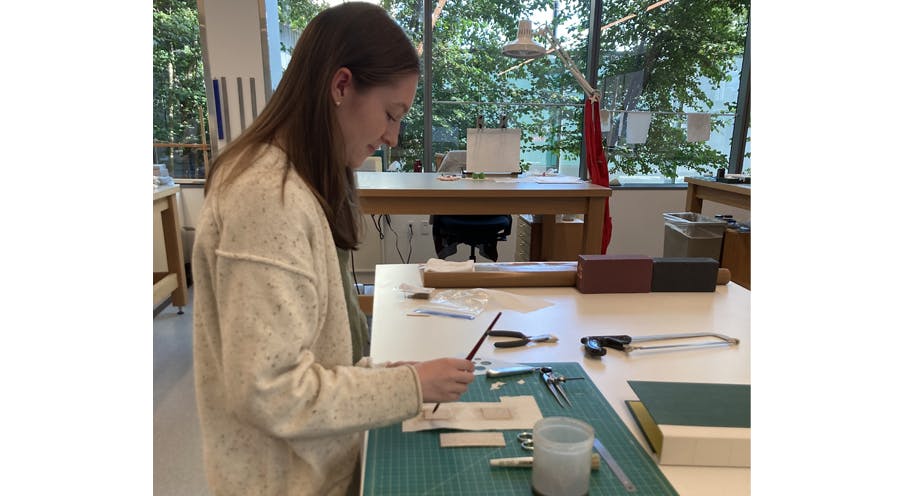
Abigail Mead recently completed a 10 week internship in Conservation Services. The internship was designed for someone interested in pursuing a career in the conservation of book and paper collections. Having recently completed her undergraduate degree with a major in art history and a minor in chemistry, Abigail was an ideal candidate and we were delighted to have her working with us over the summer. Abigail shares some of the projects she worked on here.
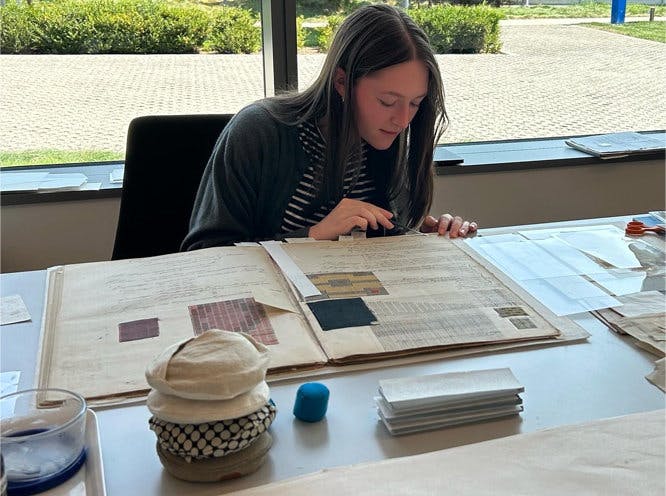
I have been interning with Conservation Services this summer, and it has been a wonderful experience that has given me a greater understanding of the conservation of books and paper. This has been my first hands-on experience in conservation, and I’m grateful for the new knowledge that will benefit me going forward in the pursuit of further conservation training. I have worked on a variety of projects with staff in Conservation Services, all of which have given me a well-rounded perspective on the day-to-day work of a conservator in an academic library.
Books with photographic prints
The first treatment I worked on involved a book from the Works Progress Administration (WPA) Report on W.P.A. Paleontological Project that included black-and-white photographic prints. With this project, I worked on my first treatment documentation report, which taught me ways to view and describe books and conservation techniques. The primary treatment this book needed involved the photographs, as many had become partially or fully detached. In order to reattach the photographs, I made photo corners out of Japanese Paper and attached them with wheat starch paste. This is a method of securing the photos without direct adhesive application to the photos themselves. Another WPA book I worked on, Mt. Hood Timberline Lodge : the realization of a community vision made possible by the Works Progress Administration also had photographic prints and needed similar treatment. In this case, however, some of the unadhered photographs had creased and folded corners. This was remedied with localized humidification. I enjoyed working on these two projects, and they were great introductions to working with photographs, and the process of describing and recording books, their condition issues, and conservation procedures.
Weaving manual
Another project I’ve worked on has been the treatment of a two-volume 19th century weaving manual from Lyon, France, Cours de Theorie. One volume is still housed in its original stationery binding. Stationery bindings were used for written records and can be found in a variety of styles and sizes depending on their purpose. In this instance, the first volume is a long stitch-style binding with green paper and parchment case. In the second volume, the folios are laid in a stack and the case binding is missing. The manuals include drawings of looms, textile pattern designs, and textile samples.

In both volumes, the sewing is broken and no longer holding the pages together. There are also many loose textile samples and torn pages especially at the edges and in the spine folds. We proposed a few treatment options to the curators. Options were resewing the gatherings into the existing case for volume 1 and, creating a new case for the second volume, or leaving the sections unsewn and laid in the existing and a new case. It was decided to leave the gatherings unsewn and create a case for the second volume to protect the exposed folios.
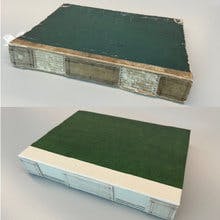
We decided to make a model of the first volume to gain a better understanding of the structure. The model was not to be an exact copy but would incorporate elements of the original. I made toned paper for the end sheets and paste downs as well as paste paper for the spine and board covering. This was my first introduction to paste paper, a traditional method for decorating book cover papers dating from the late 16th to 19th centuries. I enjoyed the process of making them as well as learning about their history. I then created the gatherings out of a paper that was a similar weight to the original and started to assemble. We decided to sew the gathering together for the model, and we based it on the remnants of the sewing structure left behind in the two volumes. I found the model-making process to be greatly valuable as it not only made me closely dissect the original material, but also learned important skills such as making paste paper, toning paper, and constructing a case.
Because the second volume didn’t have a case, there was significant damage to the edges of the leaves and in the spine area. Before any repairs could be done, the volumes needed thorough dry cleaning with soot sponges and softer makeup sponges. After cleaning, I learned to repair scarf tears as well as larger losses. I used two different Japanese papers in these repairs, a lighter weight Tengucho, and a medium weight Japanese paper.
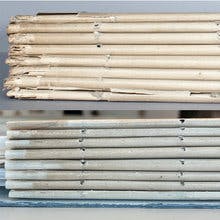
These are strong, long-fibered papers commonly used in conservation paper repair. For the larger areas of loss, the Tengucho was applied on the verso and the heavier paper on the recto. There were many areas with creased and folded paper, so I used a light mister to humidify and then flatten these areas. I found this to be a time consuming yet rewarding process. Even after just a few repairs, it was remarkable how stable the once brittle and crumbling areas became. The next area of the weaving manuals that needed attention was the textile samples adhered inside the volumes. Many had become detached and were folded and creased. During a workshop by a textile conservator held in the lab, we got advice on how to approach these textile samples.
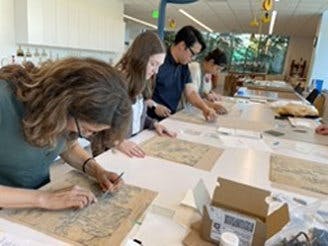
First, they needed to be gently cleaned with a soft brush or vacuum, then humidified and flattened. Finally, for reattachment, we used a combination of wheat starch paste and a heat-activated adhesive, Beva. This was a wonderful introduction to textile conservation, as well as seeing a collaboration between conservation disciplines. Overall, this project with the weaving manuals was an incredibly interesting and valuable experience.
Enclosure projects
Additionally, during this internship, I worked once a week with conservation technicians on a variety of projects. I assisted on some housing projects, such as mylar encapsulation project of the Robbie Conal Posters, a collection of political protest posters recently acquired by the Art Library. I also made clam shell boxes, measured for Kasemake boxes, customizing them when needed, and removed photographs from frames. In addition, I worked on a custom enclosure for 15th century Pilgrim Badges.

This involved measuring the badges and creating a layout on Volara foam sheets. I then cut recesses for the individual badges so that they would be well protected. I also learned how to use heat-set tissue to repair paper tears on circulating maps. It was interesting to see the diversity of items that came through the lab for the conservation technicians to work on, and I enjoyed the variety of projects I was able to assist with.
In conclusion
During this internship, I not only got to learn about different treatment methods but also the day-to-day work of book and paper conservators in an academic library. I was fortunate to join in on tours of the conservation labs at the Legion of Honor and the San Francisco Public Library. It was interesting to see how work at an academic library, museum, and public library differs not only in the materials being treated but also in the perspectives on treatment approaches. In addition to treatment, I was able to see and experience some of the work the conservators do outside of the lab. I attended a handling training session hosted by one of the conservators. Not only did I learn valuable information from this session, but it was also nice to see different library departments coming together to learn best practices when handling collection materials. Overall, this has been an incredible experience, and I feel as though I have learned a lot in a short period of time. This was a wonderful introduction to book and paper conservation, and I am looking forward to continuing my education and training in conservation.